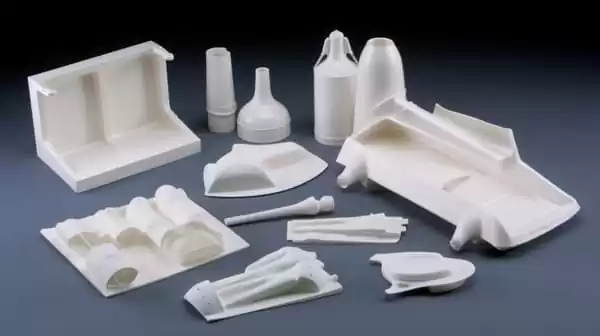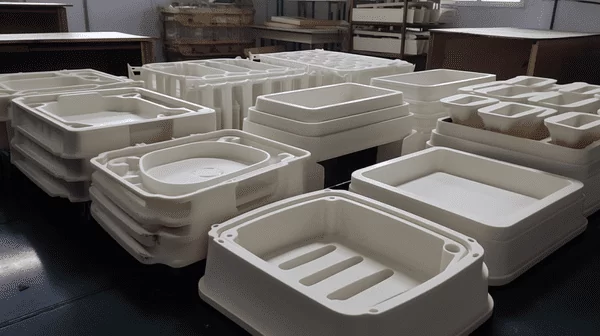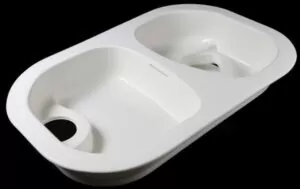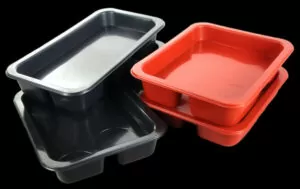Introduction
Vacuum forming is a widely used manufacturing process in the production of plastic parts and products. It involves the shaping of heating thin plastic sheets using molds. Molds play a crucial role in this process, as they determine the final shape and design of the vacuum-formed product. Understanding the importance of molds in vacuum forming is essential to comprehend the overall production process and its impact on the quality and functionality of the final products.
Vacuum forming begins with a plastic sheet that is heated until it becomes pliable. The heated sheet is then placed over a mold and vacuum pressure is applied, causing the sheet to conform to the shape of the mold. As the plastic cools and solidifies, it retains the shape of the mold, resulting in the final product.
Molds are central to the vacuum forming process as they provide the desired shape, texture, and details to the finished product. The molds can be categorized into two main types: positive molds (also known as male molds) and negative molds (also known as female molds).
Positive molds replicate the shape and features of the desired product. They are typically created by sculpting or machining a solid block of material, such as wood or foam. Positive molds accurately capture the intricate details, curves, and surface textures of the intended product. They are often used in custom fabrication, prototyping, and small-scale production.

On the other hand, negative molds have the inverse shape of the final product. They are formed by casting or shaping a moldable material, such as clay or silicone, around a positive model. Negative molds allow the heated plastic sheet to be shaped by applying negative pressure during the vacuum forming process. They are commonly employed in large-scale production to create uniform parts efficiently and with reduced material waste.
Both positive and negative molds have their advantages and limitations. Positive molds excel in replicating complex designs and fine details, while negative molds simplify the mold design and enable precise control over wall thickness. Understanding the characteristics and applications of each type of mold is essential for manufacturers to optimize their vacuum forming processes and achieve high-quality, cost-effective, and dimensionally accurate final products.
In the following sections, we will delve deeper into the differences and applications of positive and negative molds in vacuum forming, exploring their unique features, advantages, and limitations. By gaining a comprehensive understanding of these molds, manufacturers can make informed decisions and achieve optimal results in their vacuum forming operations.
II.Positive Molds in Vacuum Forming
A. Definition and Function:
Positive mold, also known as male molds, are an essential component in the vacuum forming process. They are specifically designed to replicate the desired shape and features of the final product. Positive molds are typically created by sculpting or machining a solid block of material, such as wood or foam. Their primary function is to impart the intended details and surface textures onto the vacuum-formed plastic sheet.
B. Design and Applications:
The design process for positive molds involves careful consideration of the desired shape, dimensions, and surface characteristics of the final product. Skilled artisans or CNC machining techniques are commonly employed to create these molds accurately. Positive molds find applications in various areas, including:
1.Custom Fabrication:
Positive molds are often used in the production of unique, one-of-a-kind products. They allow for the replication of intricate designs and specific details, catering to individual customization requirements.
2.Prototyping:
Positive molds play a crucial role in the prototyping phase of product development. By accurately reproducing the desired shape, they allow manufacturers to evaluate and test the functionality and aesthetics of the product before proceeding to mass production.
C. Advantages and Limitations:
Positive molds offer several advantages in the vacuum forming process, such as:
1.Detailed Features:
Positive molds can replicate complex curves, fine details, and specific surface textures with high precision. This ability enables the production of visually appealing and realistic-looking products.
2.Accurate Replication:
Positive molds ensure that the vacuum-formed parts match the original design or prototype precisely. This accuracy is crucial when consistency and conformity to specific dimensions and shapes are required.
However, positive molds also have some limitations:
1.Suitability for Small Runs:
Positive molds are well-suited for producing a limited quantity of parts. Due to the intricate design and fabrication process, they may not be as cost-effective or time-efficient for large-scale production.
2.Limited Dimensional Accuracy:
Achieving extremely tight tolerances and complex geometries may be challenging with positive molds. The manufacturing process and material constraints can result in slight variations or deviations from the mold surface intended dimensions.
Understanding these advantages and limitations helps manufacturers make informed decisions about when and where to employ positive molds in vacuum forming processes.
III. Negative Molds in Vacuum Forming process
A. Definition and Purpose:
Negative mold, also referred to as the female mold or molds, are crucial elements in the vacuum forming process. They have the inverse shape of the final product and are created by forming or casting a moldable material, such as clay or silicone, around a positive model. The primary purpose of negative molds is to shape the heated plastic sheet during the vacuum forming process, allowing it to conform to the mold’s cavity.
B. Design and Applications:
The design process for negative molds involves encapsulating the positive model with the moldable material, creating a cavity that represents the desired shape of the final product. Negative molds find applications in various areas, including:
1.Large-Scale Production:
Negative molds are often utilized when manufacturing a significant quantity of uniform parts. Their simplified design allows for efficient production processes, making them suitable for high-volume production requirements.

2.Reduced Material Waste:
Negative molds require less material for their construction compared to positive molds. This feature helps reduce production costs and minimizes material waste, making them cost-effective for large-scale manufacturing.
C. Advantages and Limitations:
Negative molds offer several advantages in the vacuum forming process, including:
1.Simplified Design:
The process of creating negative molds is generally simpler and faster than that of positive molds. This aspect contributes to increased production efficiency, particularly in large-scale manufacturing.
2.Reduced Material Waste:
Negative molds require less material due to their simplified design, resulting in lower production costs and minimized material waste.

However, negative molds also have some limitations:
1.Precise Wall Thickness Control:
Achieving precise control over wall thickness can be challenging with negative molds. Manufacturers need to carefully manage the forming temperature, heating time, and other parameters to ensure consistent and desired results.
2.Limited Dimensional Accuracy:
Negative molds may have limitations in achieving extremely tight tolerances and complex geometries. The forming process and material properties can result in slight variations from the intended dimensions.
Understanding the advantages and limitations of negative molds helps manufacturers determine their suitability for specific production requirements. By considering factors such as volume, cost, and dimensional accuracy, manufacturers can make informed decisions when utilizing negative molds in vacuum forming processes.
III. Advantages and Disadvantages of Vacuum Forming
A. Advantages:
Vacuum forming offers several advantages in the manufacturing of plastic parts and products. Some of the key advantages include:
1.Lower Cost:
Vacuum forming is a cost-effective manufacturing method compared to other processes like injection molding. The tooling costs for molds used in vacuum forming are generally lower, making it an attractive option for businesses with budget constraints.
2.Fast Lead Times:
Vacuum forming processes typically have shorter lead times compared to other manufacturing methods. The simplified injection mold designs and the absence of complex machinery enable quicker production cycles, allowing for faster turnaround times.
3.Suitable for Thin Walls and Large Surface Areas:
Vacuum forming is well-suited for creating parts with thin walls and large surface areas. The process allows for the efficient distribution of material, resulting in lightweight yet sturdy products.
4.Versatile Material Selection:
Vacuum forming offers multiple options for material selection. Polyvinyl chloride (PVC) and various other plastic materials can be used in the process, providing flexibility in meeting specific product requirements.
5.Customization and Design Freedom:
Vacuum forming allows for customization and design freedom. With positive molds, intricate details and textures can be accurately replicated, while negative molds enable the production of consistent shapes and dimensions for large-scale manufacturing.
B. Disadvantages:
Despite its advantages, vacuum forming also has some limitations that need to be considered. These include:
1.Limited Dimensional Accuracy:
Vacuum forming may have limitations in achieving extremely tight dimensional tolerances. Factors such as the forming temperature, cooling, pressure forming process, and material properties can result in slight variations from the intended dimensions.
1.Slower Cooling Process:
The cooling process in vacuum forming machines can be slower, especially for large and thick parts. This can impact the overall production time, particularly when multiple parts are being formed simultaneously.
2.Surface Quality:
The surface finish of vacuum-formed parts may not be as smooth or refined as those produced by other manufacturing processes like injection molding. Additional finishing steps may be required to achieve the desired surface quality.

3.Material Waste:
Vacuum forming can generate excess plastic material, especially in the trimming process where the excess material is removed from sheet surface of the formed parts. Proper material management and recycling practices are important to minimize waste.
While vacuum forming has its limitations, understanding these factors allows manufacturers to make informed decisions about its use. By considering the specific requirements of the project and balancing the advantages and disadvantages, businesses can leverage vacuum forming as a cost-effective and versatile manufacturing method for a wide range of products.

Conclusion:
In conclusion, understanding the differences and applications of positive and negative molds in the vacuum forming process is crucial for efficient and successful production. Positive molds, also known as male mold molds, replicate the desired shape and features of the final product. They are well-suited for custom fabrication, prototyping, and producing intricate designs with detailed features. On the other hand, negative molds, or female molds, have the inverse shape of the final product and are ideal for large-scale production, providing uniformity and reduced material waste.
By comprehending the characteristics and advantages of both positive and negative molds, manufacturers can make informed decisions about which type of mold to use based on their specific production requirements. Positive molds excel in capturing intricate details and surface textures, while negative molds simplify the mold design and offer reduced material waste. Each type of mold has its own advantages and limitations, and considering these factors helps optimize the vacuum forming process.
Vacuum forming as a whole offers numerous benefits, including lower cost, fast lead times, and the ability to produce parts with thin walls and large surface areas. The versatility of material selection and customization options further enhance its appeal in various industries. While there are limitations, such as limited dimensional accuracy and slower cooling processes, understanding and mitigating these challenges through proper planning and execution can lead to successful vacuum-formed products.
In summary, the use of positive and negative molds in vacuum forming provides manufacturers with the flexibility to produce a wide range of plastic parts and products efficiently and cost-effectively. By leveraging the strengths of each type of mold and understanding the specific requirements of the project, businesses can achieve high-quality results in industries ranging from custom fabrication and prototyping to large-scale production for diverse applications.







